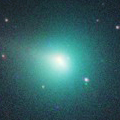
|
Now it is bright as 9.2 mag (Feb. 5, Osamu Miyazaki). It stays bright as 9-10 mag until March. In the Northern Hemisphere, it stays observable in excellent condition for a long time. In the Southern Hemisphere, it stays extremely low after this.
Date(TT) R.A. (2000) Decl. Delta r Elong. m1 Best Time(A, h)
Feb. 12 1 53.55 11 53.6 1.318 1.312 67 9.0 19:04 ( 68, 48)
Feb. 19 2 12.34 16 29.5 1.358 1.323 66 9.2 19:10 ( 76, 47)
|
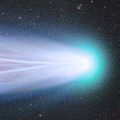
|
It brightened up to 3 mag from mid December to late December. Now it is fading. It faded down to 8.5 mag in late January (Jan. 28, Chris Wyatt). In the Southern Hemisphere, it becomes unobservable temporarily in early February. But it will appear in the morning sky in mid February. In the Northern Hemisphere, it will become observable again at 13 mag in late April.
Date(TT) R.A. (2000) Decl. Delta r Elong. m1 Best Time(A, h)
Feb. 12 21 29.70 -35 28.3 1.876 1.027 21 10.0 5:24 (296,-26)
Feb. 19 21 26.98 -35 11.8 1.943 1.134 25 10.5 5:17 (298,-22)
|
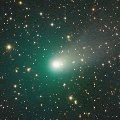
|
Now it is 9.3 mag (Feb. 7, Chris Wyatt). It stays bright as 10 mag until spring for a long time. It stays observable in good condition for a long time. It locates somewhat low in the Southern Hemisphere,
Date(TT) R.A. (2000) Decl. Delta r Elong. m1 Best Time(A, h)
Feb. 12 6 38.20 24 33.0 2.794 3.568 135 10.0 21:09 ( 0, 79)
Feb. 19 6 35.82 23 12.2 2.877 3.574 128 10.1 20:39 ( 0, 78)
|
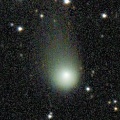
|
Now it is bright as 11.8 mag (Feb. 9, Chris Wyatt). It is expected to be observable at 5-6 mag for a long time from 2022 to 2023. In the Northern Hemisphere, it stays observable in good condition until autumn. However, it is not observable at the high light from autumn to 2023 summer. In the Southern Hemisphere, it is appearing in the morning sky. It stays observable in good condition after this.
Date(TT) R.A. (2000) Decl. Delta r Elong. m1 Best Time(A, h)
Feb. 12 18 30.24 11 26.6 4.523 4.018 53 10.3 5:24 (281, 35)
Feb. 19 18 35.01 11 21.2 4.394 3.955 57 10.2 5:17 (284, 38)
|
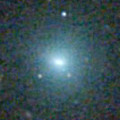
|
Brightened very rapidly. Now it is very bright as 9.4 mag (Feb. 5, Michael Jager). It will be fading after this.
Date(TT) R.A. (2000) Decl. Delta r Elong. m1 Best Time(A, h)
Feb. 12 3 18.64 8 2.2 0.658 1.153 86 10.9 19:04 ( 36, 59)
Feb. 19 3 54.86 10 9.6 0.683 1.189 88 11.4 19:10 ( 37, 61)
|
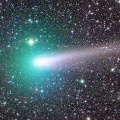
|
Now it is bright as 10.7 mag (Feb. 9, Chris Wyatt). It stays observable in good condition for a long time. It locates somewhat low in the Southern Hemisphere,
Date(TT) R.A. (2000) Decl. Delta r Elong. m1 Best Time(A, h)
Feb. 12 8 24.48 28 13.5 0.761 1.714 157 11.1 22:55 ( 0, 83)
Feb. 19 8 22.77 27 39.5 0.840 1.768 150 11.5 22:26 ( 0, 83)
|
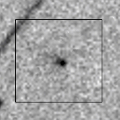
|
Now it is 12.7 mag (Feb. 4, Thomas Lehmann). In the Northern Hemisphere, it stays extremely low until spring. In the Southern Hemisphere, it stays observable at 11 mag until June.
Date(TT) R.A. (2000) Decl. Delta r Elong. m1 Best Time(A, h)
Feb. 12 19 4.54 -20 31.4 2.250 1.591 37 11.3 5:24 (302, 8)
Feb. 19 19 27.42 -20 0.4 2.208 1.577 39 11.2 5:17 (301, 8)
|
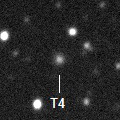
|
Now it is 12.7 mag (Feb. 9, Chris Wyatt). It will brighten up to 11.5 mag in spring. It stas observable in good condition for a long time.
Date(TT) R.A. (2000) Decl. Delta r Elong. m1 Best Time(A, h)
Feb. 12 12 7.43 -28 46.7 3.716 4.353 124 11.8 2:41 ( 0, 26)
Feb. 19 12 6.14 -28 10.8 3.625 4.340 131 11.8 2:12 ( 0, 27)
|
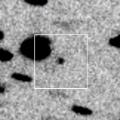
|
Now it is 14.7 mag (Feb. 3, Giuseppe Pappa). It stays 12-13 mag for a while. But actually, it is fainter than this ephemeris recently.
Date(TT) R.A. (2000) Decl. Delta r Elong. m1 Best Time(A, h)
Feb. 12 17 46.61 -21 20.4 1.876 1.558 56 12.3 5:24 (317, 20)
Feb. 19 18 9.18 -21 58.5 1.830 1.550 57 12.2 5:17 (317, 19)
|
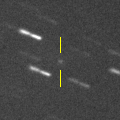
|
Now it is bright as 12.6 mag (Feb. 4, Katsumi Yoshimoto). It stays 13 mag until spring. In the Northern Hemisphere, it is observable only until early March. In the Southern Hemisphere, it is not observable until late May. But it will be observable in good condition after that.
Date(TT) R.A. (2000) Decl. Delta r Elong. m1 Best Time(A, h)
Feb. 12 20 21.47 48 58.5 1.411 1.342 65 13.0 5:24 (229, 30)
Feb. 19 21 21.80 48 1.5 1.423 1.270 60 12.8 5:17 (227, 24)
|
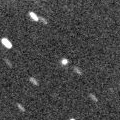
|
Now it is 15.5 mag (Jan. 22, Ken-ichi Kadota). It is expected to brighten very rapidly up to 4.5 mag in April. However, it is not observable at the high light. In the Northern Hemisphere, it stays observable until early February when it brightens up to 14 mag. Then it will appear at 6 mag in mid May, and it stays observable in good condition after that while the comet will be fading. In the Southern Hemisphere, it is not observable until August.
Date(TT) R.A. (2000) Decl. Delta r Elong. m1 Best Time(A, h)
Feb. 12 23 8.11 0 16.4 2.427 1.596 25 14.0 19:04 ( 85, 8)
Feb. 19 23 20.36 0 2.5 2.349 1.472 21 13.5 19:10 ( 88, 3)
|
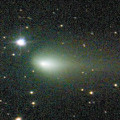
|
It brightened up to 10.6 mag in autumn (Oct. 10, Osamu Miyazaki). Now it is fading. It has already faded down to 12.6 mag (Feb. 7, Chris Wyatt). It stays observable in good condition for a long time.
Date(TT) R.A. (2000) Decl. Delta r Elong. m1 Best Time(A, h)
Feb. 12 6 21.75 11 11.5 1.437 2.217 131 13.5 20:53 ( 0, 66)
Feb. 19 6 24.53 11 51.8 1.539 2.259 125 13.9 20:28 ( 0, 67)
|

|
Now it is bright as 11.1 mag (Jan. 24, Charles S. Morris). It has a large diffuse coma.
Date(TT) R.A. (2000) Decl. Delta r Elong. m1 Best Time(A, h)
Feb. 12 4 16.30 29 37.8 5.636 5.957 104 13.6 19:04 ( 34, 84)
Feb. 19 4 17.57 29 28.3 5.748 5.959 97 13.6 19:10 ( 65, 78)
|

|
Now it is 15.8 mag (Jan. 18, J. Drummond). It will brighten up to 13 mag in spring. In the Southern Hemisphere, it stays observable in good condition for a long time. In the Northern Hemisphere, it is not observable until autumn.
Date(TT) R.A. (2000) Decl. Delta r Elong. m1 Best Time(A, h)
Feb. 12 11 16.57 -68 5.8 3.105 3.359 96 13.7 1:51 ( 0,-13)
Feb. 19 10 39.66 -69 38.8 3.040 3.335 98 13.6 0:47 ( 0,-15)
|
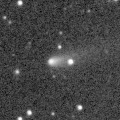
|
Now it is 14.0 mag (Feb. 9, Chris Wyatt). It is observable at 13.5 mag in good condition until spring.
Date(TT) R.A. (2000) Decl. Delta r Elong. m1 Best Time(A, h)
Feb. 12 9 50.51 18 29.8 1.458 2.442 174 14.0 0:25 ( 0, 73)
Feb. 19 9 44.65 18 52.7 1.442 2.422 170 13.9 23:47 ( 0, 74)
|
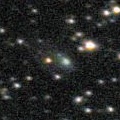
|
Now it is 14.9 mag (Nov. 28, Thomas Lehmann). It is expected to brighten up to 11 mag from spring to summer. In the Southen Hemisphere, it is not observable until February, but it stays observable in good condition for a long time after that. In the Northern Hemisphere, it is hardly observable after this.
Date(TT) R.A. (2000) Decl. Delta r Elong. m1 Best Time(A, h)
Feb. 12 19 56.67 -14 13.9 3.184 2.331 25 14.2 5:24 (289, 3)
Feb. 19 20 3.90 -15 29.8 3.073 2.277 30 14.0 5:17 (292, 4)
|

|
It brightened up to 12.3 mag from spring to summer (June 15, Marco Goiato). Now it is fading. It has already faded down to 14.1 mag (Feb. 9, Chris Wyatt).
Date(TT) R.A. (2000) Decl. Delta r Elong. m1 Best Time(A, h)
Feb. 12 14 17.50 13 13.3 3.851 4.334 113 14.0 4:51 ( 0, 68)
Feb. 19 14 12.29 15 7.5 3.785 4.373 120 14.0 4:18 ( 0, 70)
|
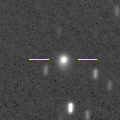
|
Now it is 14.4 mag (Feb. 8, Thomas Lehmann). It is expected to brighten up to 10 mag in 2023. In the Northern Hemisphere, it stays observable in good condition until 2023 autumn. In the Southern Hemipshere, it locates extremely low from January to February. Then it stays unobservable until 2023 summer.
Date(TT) R.A. (2000) Decl. Delta r Elong. m1 Best Time(A, h)
Feb. 12 12 50.98 51 32.1 4.508 5.157 126 14.4 3:25 (180, 74)
Feb. 19 12 43.49 53 21.8 4.432 5.100 127 14.3 2:50 (180, 72)
|
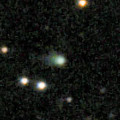
|
Now it is 14.4 mag (Feb. 8, Toshihiko Ikemura, Hirohisa Sato). It is expected to brighten up to 11 mag in 2023. In the Northern Hemisphere, it stays observable in good condition for a long time. It is not observable in the Southern Hemisphere.
Date(TT) R.A. (2000) Decl. Delta r Elong. m1 Best Time(A, h)
Feb. 12 16 42.66 33 58.0 5.083 5.101 85 14.6 5:24 (265, 67)
Feb. 19 16 41.60 34 49.2 4.965 5.060 89 14.5 5:17 (264, 72)
|

|
Now it is 15.3 mag (Feb. 3, Thomas Lehmann). Appearing in the morning. It will brighten up to 13 mag in summer.
Date(TT) R.A. (2000) Decl. Delta r Elong. m1 Best Time(A, h)
Feb. 12 17 46.72 -25 7.6 3.567 3.124 55 14.7 5:24 (319, 17)
Feb. 19 17 56.71 -25 22.9 3.477 3.116 60 14.6 5:17 (321, 18)
|

|
Now it is 15.7 mag (Feb. 2, Thomas Lehmann). It will brighten up to 12.5 mag in summer. In the Southern Hemisphere, it stays observable in excellent condition for a long time, although it becomes low temporarily in February. In the Northern Hemisphere, it is not observable until August.
Date(TT) R.A. (2000) Decl. Delta r Elong. m1 Best Time(A, h)
Feb. 12 22 27.81 -57 34.7 4.275 3.639 44 14.8 19:04 ( 38,-30)
Feb. 19 22 30.84 -56 42.1 4.224 3.600 45 14.7 19:10 ( 41,-33)
|
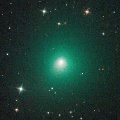
|
It brightened up to 9.5 mag in early summer (June 27, Marco Goiato). Now it is fading. It has faded down to 12.7 mag in autumn (Nov. 22, Thomas Lehmann). Now it is not observable. In the Southern Hemisphere, it will appear in the morning sky at 15 mag in late February. In the Northern Hemisphere, it is not observable until June when the comet will fade down to 17 mag.
Date(TT) R.A. (2000) Decl. Delta r Elong. m1 Best Time(A, h)
Feb. 12 21 1.12 -32 18.9 4.111 3.205 20 15.0 5:24 (296,-20)
Feb. 19 21 13.33 -32 3.1 4.139 3.262 24 15.1 5:17 (297,-18)
|

|
Now it is 16.0 mag (Feb. 3, Thomas Lehmann). It stays at 15-16 mag for a long time. In the Southern Hemisphere, it stays observable in excellent condition for a long time. In the Northern Hemiphere, it locates extremely low in spring.
Date(TT) R.A. (2000) Decl. Delta r Elong. m1 Best Time(A, h)
Feb. 12 17 19.28 -34 33.5 5.439 5.053 62 15.2 5:24 (329, 12)
Feb. 19 17 20.52 -35 35.3 5.335 5.061 68 15.2 5:17 (333, 13)
|
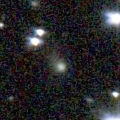
|
Now it is 15.6 mag (Jan. 31, Thomas Lehmann). It is expected to brighten up to 11 mag in 2023. In the Northern Hemisphere, it stays observable in good condition until November. But it becomes unobservable after that. In the Southern Hemisphere, it is appearing in the morning sky. It stays observable in good condition after this.
Date(TT) R.A. (2000) Decl. Delta r Elong. m1 Best Time(A, h)
Feb. 12 18 44.14 17 18.8 5.707 5.184 53 15.4 5:24 (273, 36)
Feb. 19 18 48.00 17 18.7 5.603 5.136 57 15.3 5:17 (276, 39)
|
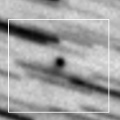
|
Now it is 15.9 mag (Jan. 30, ATLAS-MLO, Mauna Loa). It is expected to brighten up to 11 mag in summer. In the Northern Hemisphere, it stays observable in good condition until June when it brightens up to 11 mag. But it is not observable after the high light. In the Souther Hemisphere, it is not observable until October.
Date(TT) R.A. (2000) Decl. Delta r Elong. m1 Best Time(A, h)
Feb. 12 23 28.13 51 7.2 2.872 2.683 69 15.6 19:04 (132, 35)
Feb. 19 23 40.37 51 28.8 2.842 2.602 66 15.4 19:10 (134, 32)
|
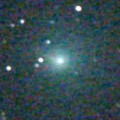
|
It brightened up to 9.8 mag from autumn to winter (Nov. 22, Thomas Lehmann). Now it is fading. It has already faded down to 14.4 mag (Jan. 24, Charles S. Morris). It will be fainter than 18 mag in March.
Date(TT) R.A. (2000) Decl. Delta r Elong. m1 Best Time(A, h)
Feb. 12 1 29.40 -8 10.9 2.457 2.076 56 15.5 19:04 ( 54, 29)
Feb. 19 1 43.34 -6 29.8 2.565 2.126 53 16.1 19:10 ( 60, 27)
|
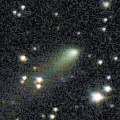
|
Now it is 15.6 mag (Jan. 7, Toshihiko Ikemura, Hirohisa Sato). It will be fading after this. In the Northern Hemisphere, it stays observable in good condition for a long time. It locates low in the Southern Hemisphere.
Date(TT) R.A. (2000) Decl. Delta r Elong. m1 Best Time(A, h)
Feb. 12 15 50.63 30 25.3 2.479 2.746 94 15.5 5:24 (286, 77)
Feb. 19 15 40.28 32 56.6 2.408 2.787 102 15.5 5:17 (288, 84)
|
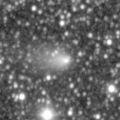
|
It brightened up to 11.5 mag in outburst in October (Oct. 22, Marco Goiato). Now it is fading. It has already faded down to 15.1 mag (Jan. 24, A. Diepvens). But Hiroshi Abe reported it is bright as 12.3 mag on Jan. 22. In the Southern Hemisphere, it is already unobservable. In the Northern Hemisphere, it stays observable until early February.
Date(TT) R.A. (2000) Decl. Delta r Elong. m1 Best Time(A, h)
Feb. 12 23 16.32 -4 22.4 2.868 2.020 25 15.5 19:04 ( 80, 7)
Feb. 19 23 31.78 -2 49.7 2.931 2.052 22 15.8 19:10 ( 84, 4)
|
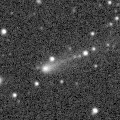
|
It brightened rapidly. Now it is 15.1 mag (Jan. 31, Toshihiko Ikemura, Hirohisa Sato). It stays 15 mag until February, and it is observable in excellent condition.
Date(TT) R.A. (2000) Decl. Delta r Elong. m1 Best Time(A, h)
Feb. 12 7 58.63 14 0.5 1.628 2.558 155 15.5 22:29 ( 0, 69)
Feb. 19 7 54.89 13 48.6 1.681 2.570 147 15.7 21:58 ( 0, 69)
|
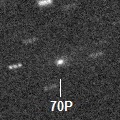
|
Now it is 15.8 mag (Feb. 8, Toshihiko Ikemura, Hirohisa Sato). It stays 15.5 mag until March, and it is observable in excellent condition.
Date(TT) R.A. (2000) Decl. Delta r Elong. m1 Best Time(A, h)
Feb. 12 11 53.20 8 55.7 1.270 2.167 147 15.7 2:27 ( 0, 64)
Feb. 19 11 50.84 9 46.7 1.253 2.188 154 15.7 1:57 ( 0, 65)
|
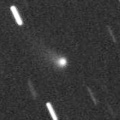
|
Now it is 14.5 mag (Feb. 8, Toshihiko Ikemura, Hirohisa Sato). It stays observable at 15 mag for a long time.
Date(TT) R.A. (2000) Decl. Delta r Elong. m1 Best Time(A, h)
Feb. 12 12 36.06 11 33.7 2.674 3.465 137 15.7 3:10 ( 0, 66)
Feb. 19 12 24.67 11 9.8 2.631 3.498 146 15.8 2:31 ( 0, 66)
|
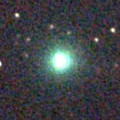
|
It brightened very rapidly, and brightened up to 8.9 mag (Sept. 11, Chris Wyatt). Now it is fading. It has already faded down to 15.7 mag (Dec. 7, E. Cortes, N. Paul, B. Lutkenhoner). In the Southern Hemisphere, it stays observable after this while the comet will be fading. It is not observable after this in the Northern Hemisphere.
Date(TT) R.A. (2000) Decl. Delta r Elong. m1 Best Time(A, h)
Feb. 12 17 28.64 -54 59.6 2.729 2.451 63 16.0 5:24 (338, -6)
Feb. 19 17 38.45 -55 12.5 2.721 2.520 67 16.3 5:17 (340, -6)
|
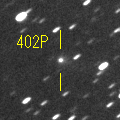
|
First return of a new periodic comet observed at 16 mag from 2003 to 2004. Now it is 15.8 mag (Jan. 24, Y. Sugiyama). It stays 16 mag until March, and it stays observable in excellent condition.
Date(TT) R.A. (2000) Decl. Delta r Elong. m1 Best Time(A, h)
Feb. 12 6 0.65 8 46.0 3.293 3.953 125 16.0 20:31 ( 0, 64)
Feb. 19 6 0.37 9 43.9 3.380 3.956 119 16.1 20:04 ( 0, 65)
|
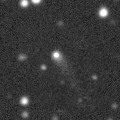
|
Now it is 16.0 mag (Jan. 15, Ken-ichi Kadota). It stays observable at 16 mag from 2021 to 2022. Appearing in the morning sky also in the Southern Hemisphere.
Date(TT) R.A. (2000) Decl. Delta r Elong. m1 Best Time(A, h)
Feb. 12 16 11.55 17 49.1 4.767 4.821 87 16.1 5:24 (309, 65)
Feb. 19 16 14.67 19 28.8 4.691 4.833 92 16.1 5:17 (314, 69)
|
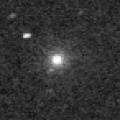
|
It was observed at 9-10 mag from late July to early August. Although it had been unobservable for a long time, it is appearing in the morning sky now.
Date(TT) R.A. (2000) Decl. Delta r Elong. m1 Best Time(A, h)
Feb. 12 16 34.88 -27 23.6 3.100 2.947 71 16.2 5:24 (335, 23)
Feb. 19 16 38.58 -28 8.7 3.078 3.032 78 16.3 5:17 (339, 24)
|

|
Now it is 16.2 mag (Jan. 27, SONEAR Observatory, Oliveira). It will be fading slowly after this. In the Southern Hemisphere, it stays observable in good condition for a long time, although it becomes extremely low temporarily from March to April. In the Northern Hemisphere, it is not observable until July.
Date(TT) R.A. (2000) Decl. Delta r Elong. m1 Best Time(A, h)
Feb. 12 0 5.05 -43 17.0 4.836 4.164 42 16.3 19:04 ( 43, -9)
Feb. 19 0 13.68 -41 37.6 4.894 4.195 40 16.3 19:10 ( 47,-12)
|
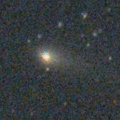
|
It brightened up to 13.1 mag in autumn (Oct. 28, Toshihiko Ikemura, Hirohisa Sato). Now it is fading. It has already faded down to 15.5 mag (Jan. 31, Thomas Lehmann). It stays observable in good condition for a long time. But it will be fainter than 18 mag in March.
Date(TT) R.A. (2000) Decl. Delta r Elong. m1 Best Time(A, h)
Feb. 12 3 1.48 11 5.4 1.755 1.910 83 16.4 19:04 ( 46, 59)
Feb. 19 3 16.25 12 17.9 1.851 1.941 80 16.7 19:10 ( 54, 57)
|

|
Brightened rapidly. Now it is 16.1 mag (Jan. 29, ATLAS-MLO, Mauna Loa). It is observable at 15.5-16 mag in good condition in winter.
Date(TT) R.A. (2000) Decl. Delta r Elong. m1 Best Time(A, h)
Feb. 12 2 28.96 11 59.5 3.954 3.834 75 16.5 19:04 ( 58, 54)
Feb. 19 2 35.01 12 18.2 4.059 3.840 70 16.5 19:10 ( 66, 49)
|
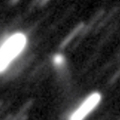
|
It was observed at 15 mag in 2021. Now it is fading. It stays observable at 17 mag for a while in 2022.
Date(TT) R.A. (2000) Decl. Delta r Elong. m1 Best Time(A, h)
Feb. 12 18 25.06 3 19.8 5.588 5.034 51 16.6 5:24 (290, 31)
Feb. 19 18 29.43 4 31.0 5.522 5.048 56 16.6 5:17 (292, 35)
|
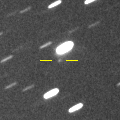
|
Now it is 16.5 mag (Jan. 29, Toshihiko Ikemura, Hirohisa Sato). It is observable at 16.5 mag in good condition from winter to spring.
Date(TT) R.A. (2000) Decl. Delta r Elong. m1 Best Time(A, h)
Feb. 12 10 20.66 -23 54.0 1.520 2.370 141 16.7 0:54 ( 0, 31)
Feb. 19 10 19.65 -21 47.1 1.489 2.377 146 16.7 0:26 ( 0, 33)
|

|
Now it is 17.2 mag (Jan. 18, J. Drummond). It brightened rapidly. It stays 17 mag for a long time from 2021 to 2022. In the Southern Hemisphere, it stays observable in good condition for a long time. In the Northern Hemisphere, it will be observable only in extremely low sky from autumn to winter.
Date(TT) R.A. (2000) Decl. Delta r Elong. m1 Best Time(A, h)
Feb. 12 7 28.07 -47 14.1 4.925 5.374 112 16.7 21:57 ( 0, 8)
Feb. 19 7 18.73 -47 4.1 4.957 5.380 110 16.7 21:20 ( 0, 8)
|
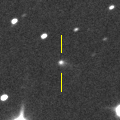
|
Now it is 16.9 mag (Jan. 31, Toshihiko Ikemura, Hirohisa Sato). It will brighten up to 14 mag in early 2023. It stays observable in good condition until spring.
Date(TT) R.A. (2000) Decl. Delta r Elong. m1 Best Time(A, h)
Feb. 12 4 19.00 6 18.4 4.421 4.705 100 16.8 19:04 ( 7, 61)
Feb. 19 4 20.50 6 57.0 4.484 4.663 94 16.7 19:10 ( 23, 60)
|
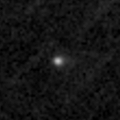
|
Now it is 18.0 mag (Jan. 31, Toshihiko Ikemura, Hirohisa Sato). It is expected to brighten up to 11 mag from summer to autumn. It stays observable in good condition in the Southern Hemisphere. In the Northern Hemisphere, it becomes extremely low from August to September.
Date(TT) R.A. (2000) Decl. Delta r Elong. m1 Best Time(A, h)
Feb. 12 10 53.62 26 44.4 1.519 2.465 158 17.1 1:28 ( 0, 82)
Feb. 19 10 45.78 28 3.0 1.452 2.409 161 16.8 0:53 ( 0, 83)
|
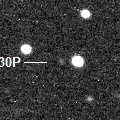
|
Now it is 18.7 mag (Jan. 1, W. Hasubick). It was expected to brighten up to 16.5-17 mag in winter. In its last apparition in 2015, it brightened up to 13 mag. But actually, it is fainter than this ephemeris recently.
Date(TT) R.A. (2000) Decl. Delta r Elong. m1 Best Time(A, h)
Feb. 12 0 58.78 -5 46.3 2.069 1.609 49 16.8 19:04 ( 62, 26)
Feb. 19 1 16.19 -3 19.6 2.092 1.595 47 16.8 19:10 ( 67, 24)
|
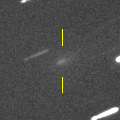
|
First return of a new periodic comet which brightened up to 17 mag in 2011. Now it is 18.2 mag (Jan. 8, Toshihiko Ikemura, Hirohisa Sato). It brightened up to 16.8 mag in October (Oct. 10, Ken-ichi Kadota), however, it has been fading after that.
Date(TT) R.A. (2000) Decl. Delta r Elong. m1 Best Time(A, h)
Feb. 12 15 1.29 -12 52.4 1.280 1.700 96 16.8 5:24 (357, 42)
Feb. 19 15 11.12 -13 39.7 1.243 1.728 100 16.8 5:17 ( 0, 41)
|

|
It has not been observed yet in this apparition. It was expected to be observable at 16 mag in good condition in spring. But actually, it is fainter than 19.2 mag (Jan. 22, John Drummond).
Date(TT) R.A. (2000) Decl. Delta r Elong. m1 Best Time(A, h)
Feb. 12 16 26.42 -34 30.1 1.475 1.516 72 17.1 5:24 (340, 17)
Feb. 19 16 53.25 -34 36.1 1.417 1.493 74 16.9 5:17 (338, 16)
|

|
Now it is 16.9 mag (Jan. 8, Toshihiko Ikemura, Hirohisa Sato). Fading slowly. In the Northern Hemisphere, it stays observable in good condition for a long time. In the Southern Hemisphere, it is not observable after this.
Date(TT) R.A. (2000) Decl. Delta r Elong. m1 Best Time(A, h)
Feb. 12 19 10.79 51 9.1 9.280 9.037 72 16.9 5:24 (229, 42)
Feb. 19 19 13.92 51 57.9 9.274 9.046 73 16.9 5:17 (229, 44)
|
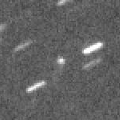
|
Now it is 16.8 mag (Jan. 23, ATLAS-MLO, Mauna Loa). It started fading before the perihelion passage. It was predicted to stay at 16 mag for a long time, but actually, it will be fainter than 18 mag in autumn. In the Northern Hemisphere, it stays observable in good condition for a long time. In the Southern Hemisphere, it is not observable until 2023.
Date(TT) R.A. (2000) Decl. Delta r Elong. m1 Best Time(A, h)
Feb. 12 23 10.60 79 29.0 3.614 3.814 94 17.0 19:04 (167, 36)
Feb. 19 23 19.81 78 10.2 3.670 3.804 90 17.0 19:10 (166, 35)
|
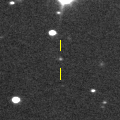
|
Now it is 16.6 mag (Jan. 29, Observatoire Chante-Perdrix, Dauban). It will brighten up to 11.5 mag in 2022 winter. It stays observable while the comet will be brightening slowly.
Date(TT) R.A. (2000) Decl. Delta r Elong. m1 Best Time(A, h)
Feb. 12 3 5.61 14 12.1 2.961 3.039 85 17.1 19:04 ( 49, 62)
Feb. 19 3 10.19 14 38.9 3.025 3.000 79 17.0 19:10 ( 60, 57)
|
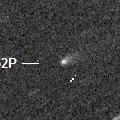
|
It brightened up to 16.4 mag from autumn to winter (Oct. 6, ATLAS-MLO, Mauna Loa). Now it is fading. It has already faded down to 18.0 mag (Jan. 31, Catalina Sky Survey).
Date(TT) R.A. (2000) Decl. Delta r Elong. m1 Best Time(A, h)
Feb. 12 12 54.91 -11 11.5 1.406 2.139 125 17.0 3:28 ( 0, 44)
Feb. 19 12 53.12 -11 55.0 1.377 2.174 132 17.1 2:59 ( 0, 43)
|
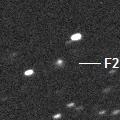
|
Now it is 17.2 mag (Jan. 28, ATLAS-HKO, Haleakala). It stays observable at 17-18 mag for a long time until 2024.
Date(TT) R.A. (2000) Decl. Delta r Elong. m1 Best Time(A, h)
Feb. 12 14 34.80 -3 42.1 8.553 8.862 105 17.1 5:08 ( 0, 51)
Feb. 19 14 32.71 -3 16.4 8.430 8.858 112 17.1 4:38 ( 0, 52)
|
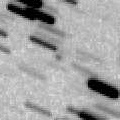
|
Now it is 17.8 mag (Jan. 2, Ken-ichi Kadota). It is expected to brighten up to 13.5 mag from June to July. It is observable only in the Southern Hemisphere at the high light. In the Northern Hemisphere, it is observable only until March when it brightens up to 16.5 mag.
Date(TT) R.A. (2000) Decl. Delta r Elong. m1 Best Time(A, h)
Feb. 12 1 12.61 4 0.8 2.493 2.096 55 17.2 19:04 ( 68, 34)
Feb. 19 1 15.40 2 31.8 2.536 2.022 48 17.1 19:10 ( 72, 28)
|
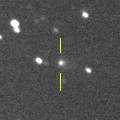
|
Now it is 17.0 mag (Jan. 29, ATLAS-MLO, Mauna Loa). It continued brightening for a while even after the perihelion passage. It stays observable at 16-17 mag in good condition for a while.
Date(TT) R.A. (2000) Decl. Delta r Elong. m1 Best Time(A, h)
Feb. 12 4 23.76 -7 13.2 3.761 4.027 98 17.1 19:04 ( 3, 48)
Feb. 19 4 25.77 -6 3.4 3.871 4.046 93 17.2 19:10 ( 15, 48)
|
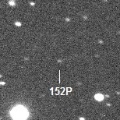
|
It will brighten up to 16 mag from spring to summer. It locates somewhat low in the Northern Hemisphere.
Date(TT) R.A. (2000) Decl. Delta r Elong. m1 Best Time(A, h)
Feb. 12 18 24.00 -21 53.2 3.681 3.099 47 17.2 5:24 (310, 14)
Feb. 19 18 34.46 -21 56.7 3.610 3.101 52 17.1 5:17 (312, 15)
|
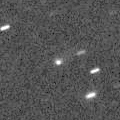
|
Now it is 17.3 mag (Jan. 7, Toshihiko Ikemura, Hirohisa Sato). It will be observable at 17 mag in good condition in spring.
Date(TT) R.A. (2000) Decl. Delta r Elong. m1 Best Time(A, h)
Feb. 12 13 43.90 -9 43.1 4.204 4.712 115 17.3 4:17 ( 0, 45)
Feb. 19 13 44.00 -9 46.3 4.107 4.710 122 17.2 3:50 ( 0, 45)
|
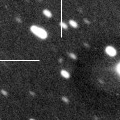
|
Now it is 17.2 mag (Jan. 22, ATLAS-HKO, Haleakala). It will brighten up to 13-14 mag from 2024 to 2025.
Date(TT) R.A. (2000) Decl. Delta r Elong. m1 Best Time(A, h)
Feb. 12 7 14.88 -31 16.7 7.878 8.454 122 17.3 21:45 ( 0, 24)
Feb. 19 7 13.00 -30 55.6 7.874 8.416 120 17.2 21:16 ( 0, 24)
|
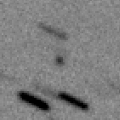
|
Now it is 17.6 mag (Jan. 19, Yasukazu Ikari). It is observable at 17 mag from November to March. It is observable in good condition in the Northern Hemisphere, but it locates low in the Southern Hemisphere.
Date(TT) R.A. (2000) Decl. Delta r Elong. m1 Best Time(A, h)
Feb. 12 5 21.44 30 51.1 1.860 2.486 118 17.3 19:53 ( 0, 86)
Feb. 19 5 24.82 31 16.8 1.930 2.478 112 17.4 19:29 ( 0, 86)
|
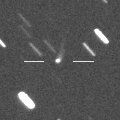
|
Now it is 18.4 mag (Jan. 9, J. Drummond). In the Southern Hemisphere, it stays observable for a long time. In the Northern Hemisphere, it is not observable after this.
Date(TT) R.A. (2000) Decl. Delta r Elong. m1 Best Time(A, h)
Feb. 12 10 51.19 -52 51.5 3.524 3.994 111 17.4 1:25 ( 0, 2)
Feb. 19 10 38.94 -51 38.4 3.504 4.044 116 17.4 0:46 ( 0, 3)
|

|
Now it is 17.8 mag (Jan. 8, Toshihiko Ikemura, Hirohisa Sato). It stays 17-18 mag for a long time from 2021 to 2022. It is observable in excellent condition in the Northern Hemisphere, It locates somewhat low in the Southern Hemisphere.
Date(TT) R.A. (2000) Decl. Delta r Elong. m1 Best Time(A, h)
Feb. 12 2 41.37 27 47.0 5.387 5.369 83 17.5 19:04 ( 81, 65)
Feb. 19 2 39.28 27 25.3 5.514 5.366 76 17.5 19:10 ( 87, 58)
|

|
Now it is 17.0 mag (Jan. 26, ATLAS-HKO, Haleakala). In the Northern Hemisphere, it stays observable for a long time while it is getting fainter slowly. In the Southern Hemisphere, it will never be observable again.
Date(TT) R.A. (2000) Decl. Delta r Elong. m1 Best Time(A, h)
Feb. 12 14 52.80 44 7.0 7.378 7.743 108 17.6 5:24 (182, 81)
Feb. 19 14 51.10 44 40.1 7.370 7.791 111 17.6 4:56 (180, 80)
|
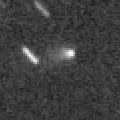
|
Now it is 16.5 mag (Jan. 26, Ken-ichi Kadota). It was expected to brighten up to 15.5 mag in winter. But actually, it is fading even before the perihelion passage. In the Northern Hemisphere, it stays observable in good condition for a long time. It is not observable at all in the Southern Hemisphere.
Date(TT) R.A. (2000) Decl. Delta r Elong. m1 Best Time(A, h)
Feb. 12 12 45.88 88 54.1 2.539 2.947 104 17.6 3:36 (180, 36)
Feb. 19 6 43.14 86 17.8 2.554 2.950 103 17.6 20:49 (180, 39)
|
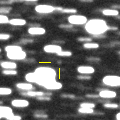
|
Now it is 17.4 mag (Jan. 29, Toshihiko Ikemura, Hirohisa Sato). It will brighten up to 15-16 mag in 2023.
Date(TT) R.A. (2000) Decl. Delta r Elong. m1 Best Time(A, h)
Feb. 12 7 1.22 -22 51.5 4.695 5.339 126 17.6 21:31 ( 0, 32)
Feb. 19 6 53.20 -22 4.6 4.708 5.293 121 17.6 20:55 ( 0, 33)
|
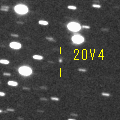
|
Now it is 16.9 mag (Jan. 31, ATLAS-HKO, Haleakala). It is observable at 17.5 mag in good condition in winter.
Date(TT) R.A. (2000) Decl. Delta r Elong. m1 Best Time(A, h)
Feb. 12 7 42.45 4 6.2 4.384 5.256 149 17.6 22:13 ( 0, 59)
Feb. 19 7 40.40 4 26.1 4.443 5.264 142 17.6 21:43 ( 0, 59)
|
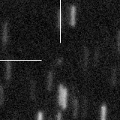
|
Now it is 17.4 mag (Jan. 10, Observatoire Chante-Perdrix, Dauban). It is expected to brighten up to 12 mag from winter to summer in 2023. In the Northern Hemisphere, it stays observable in good condition until 2023 spring. In the Southern Hemisphere, it is not observable until summer.
Date(TT) R.A. (2000) Decl. Delta r Elong. m1 Best Time(A, h)
Feb. 12 1 39.09 47 50.4 5.183 5.126 81 17.7 19:04 (125, 56)
Feb. 19 1 44.33 46 54.1 5.222 5.067 75 17.6 19:10 (124, 51)
|
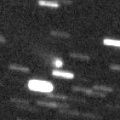
|
It was observed at 16 mag from 2020 to 2021. Now it is fading. It will be fainter than 18 mag in spring.
Date(TT) R.A. (2000) Decl. Delta r Elong. m1 Best Time(A, h)
Feb. 12 15 39.34 -37 30.9 5.941 5.884 81 17.7 5:24 (350, 17)
Feb. 19 15 36.80 -38 15.5 5.851 5.917 89 17.7 5:17 (355, 16)
|
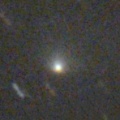
|
It brightened up to 14.5 mag in autumn (Oct. 1, Ken-ichi Kadota). Now it is fading. It has already faded down to 17.1 mag (Jan. 28, Catalina Sky Survey). It will be fading rapidly after this. It will be fainter than 18 mag in February.
Date(TT) R.A. (2000) Decl. Delta r Elong. m1 Best Time(A, h)
Feb. 12 1 10.95 -2 36.6 2.987 2.519 52 17.9 19:04 ( 63, 30)
Feb. 19 1 22.17 -1 21.6 3.073 2.538 49 18.0 19:10 ( 68, 27)
|
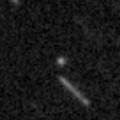
|
First return of a new periodic comet which brightened up to 16.5 mag in 1997. Now it is 18.5 mag (Jan. 28, Toshihiko Ikemura, Hirohisa Sato). It is fainter than originally predicted, but it is brightening rapidly. It is observable in good condition from January to March.
Date(TT) R.A. (2000) Decl. Delta r Elong. m1 Best Time(A, h)
Feb. 12 8 30.42 25 35.4 1.158 2.111 159 18.4 23:00 ( 0, 80)
Feb. 19 8 26.94 24 32.4 1.168 2.096 152 18.3 22:30 ( 0, 79)
|
|
![]()
 C/2019 O3 ( Palomar )
C/2019 O3 ( Palomar ) C/2020 U5 ( PanSTARRS )
C/2020 U5 ( PanSTARRS ) 81P/Wild 2
81P/Wild 2 52P/Harrington-Abell
52P/Harrington-Abell C/2020 F2 ( ATLAS )
C/2020 F2 ( ATLAS ) C/2021 T2 ( Fuls )
C/2021 T2 ( Fuls ) 254P/McNaught
254P/McNaught 152P/Helin-Lawrence
152P/Helin-Lawrence 99P/Kowal 1
99P/Kowal 1 C/2021 G2 ( ATLAS )
C/2021 G2 ( ATLAS ) 274P/Tombaugh-Tenagra
274P/Tombaugh-Tenagra C/2019 T2 ( Lemmon )
C/2019 T2 ( Lemmon ) C/2020 U4 ( PanSTARRS )
C/2020 U4 ( PanSTARRS ) C/2018 N2 ( ASASSN )
C/2018 N2 ( ASASSN ) C/2021 D2 ( ZTF )
C/2021 D2 ( ZTF ) A/2021 X1
A/2021 X1 P/2020 V4 ( Rankin )
P/2020 V4 ( Rankin ) C/2021 Y1 ( ATLAS )
C/2021 Y1 ( ATLAS ) C/2017 Y2 ( PanSTARRS )
C/2017 Y2 ( PanSTARRS ) 284P/McNaught
284P/McNaught 440P/2021 W2 ( Kobayashi )
440P/2021 W2 ( Kobayashi )![]()

































































